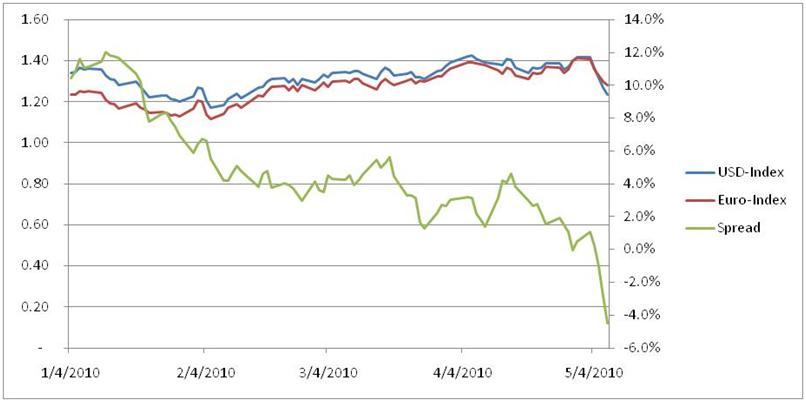While the world was busy reacting to Euro’s sudden collapse from 1.364 to 1.25 a very significant event occurred that wasn’t noticed, marked or commented on at all. Atleast it didn’t get the attention that it deserved.
Here is a hint.

The graph above plots WTI prices indexed to the relative exchange rate between USD-Euro as at 1st January 2007. The objective is to measure the relative price of oil across the two currencies over the last three and a half year. The axis on the right shows the relative difference between oil prices when measured in Euros versus US dollars. At its peak, on a relative basis, Europe in general and the Euro zone in particular was buying oil 40% cheaper than their counterparts in the US. Imagine what that does to your competitive advantage and growth prospects. A reserve currency that actually allows you to buy oil cheaper than your closest competitor!
Here is the same image using the data from January 2010 to 7th May 2010 – the trailing edge from the graph above.

From the first time in 3 years, on a relative basis oil is going to be cheaper in the US when compared to the Euro-zone. In addition to the sovereign debt crisis, the austerity measures, the public protest riots and the widespread distress and turmoil, the PIGS (Portugal, Italy, Greece, and Spain) now also need to worry about more expensive oil. Add that to the growth model and you have the making of secondary effect that would further drive down growth forecasts (and oil prices) for the region and increase economic distress across the Euro Zone. Technically speaking the sharp fall in the reserve currency, the sharp rise in sovereign debt interest rates and the reversal in economic growth would all help resolve the imbalance that caused the problem in the first place but there will be pain.
[ad#Grey back med rectangle]
Factor in lower growth in Europe in your oil price models and the 90 and 99 dollar forecasts for oil prices begin to sound like pipe dreams. Oil will head down to 70, then head up again and by the time Europe figures out the implications head all the way back to the mid 60s before start of the winter season in the western hemisphere.
[ad#Grey back med rectangle]